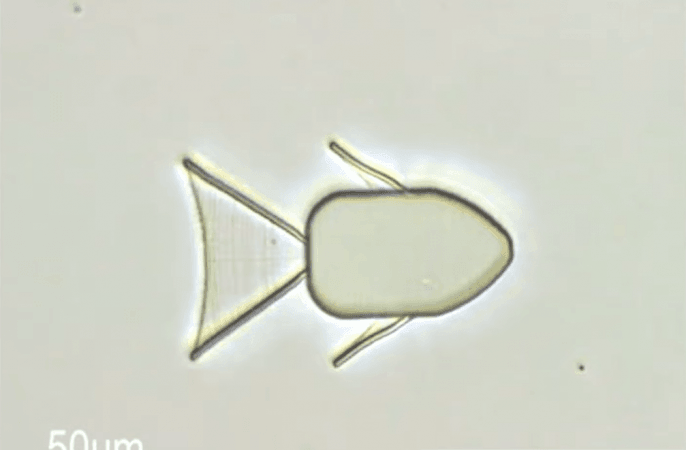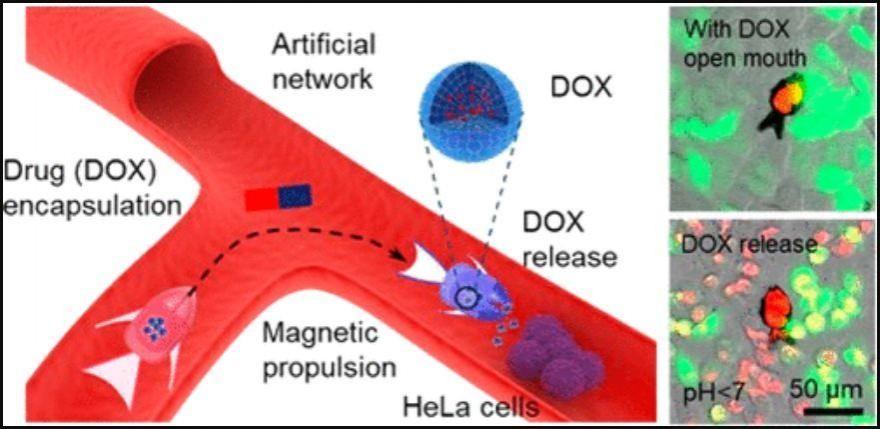Chemotherapy has remained the cornerstone of cancer treatment for decades. It has given sufferers of the disease a fighting chance at life. However, chemotherapy comes with its own set of side effects that can make the remedy as unpleasant as the ailment itself. Now, in a proof-of-concept study that could potentially inform future management of cancer, scientists have developed fish-shaped microrobots that can deliver drugs to diseased cells.
In a new multi-institutional study, researchers have created and demonstrated the ability of fish-shaped microrobots to deliver chemotherapy drugs to cancer cells. These robots are guided by magnets to cancerous cells, where the change in pH causes them to open their 'mouths' and release their anti-cancer cargo.
"Here, environmentally adaptive shape-morphing microrobots (SMMRs) have been developed by programmatically encoding different expansion rates in a pH-responsive hydrogel," wrote the authors. The study was published in the journal ACS Nano.
Tiny Animal-shaped Robots

Microscale robots, less than 100 µm, capable of manipulating minute objects are not unheard of. However, most are limited by their inability to change shapes in order to accomplish complicated tasks. This includes the release of drugs. While some 4D-printed objects—3D-printed devices that can change their shape in response to specific stimuli—exist, they usually execute simple functions. Also, it is difficult to remotely control their motion.
Cancer cells are known to exist in environments that have a lower pH (more acidic) when compared to healthy cells. Therefore, the team chose an approach that could make the new shape-morphing microrobots (SMMRs) alter their structure in response to low pH levels.

These devices were meant to deliver cancer drugs to specific regions through the guidance of magnets. For this, they 4D-printed microrobots using a hydrogel that was pH-responsive. The tiny robots were printed in the shape of a butterfly, crab, and fish.
Through modifications to printing density at specific areas of the shapes, such as the butterfly's wing or the crab's claws, the researchers encoded them with morphing abilities that made them responsive to pH. Following this, the microrobots were placed in a suspension of iron oxide (Fe3O4) nanoparticles. This made them magnetic.
Delivering Chemotherapy Drugs
After endowing the microrobots with shape-changing abilities, it was time to demonstrate their efficiency. Therefore, the authors conducted a battery of tests. One of them included testing the ability of the shape-morphing microfish (SMMF) with an adjustable 'mouth'; one that could open and close. The team showed that the 'fish' could be steered to reach cancer cells at a particular spot within a petri dish through simulated blood vessels (phosphate-buffered saline, pH ∼ 7.4).
When the pH of the solution surrounding the fish was lowered (pH < 7), it 'opened' its mouth, thereby, releasing the chemotherapy drug (doxorubicin) it was carrying. The nearby cancer cells were killed upon being exposed to the drug.

Despite the study serving as positive proof of concept, the researchers admit that the microrobots require further refining. To begin with, their size must undergo a significant reduction in order to travel across real blood vessels. Also, a viable imaging technique must be identified or devised to monitor their movements within the body.
"With the continuous optimization of size, motion control, and imaging technology, these magnetic SMMRs will provide ideal platforms for complex microcargo operations and on-demand drug release," the authors wrote.

















